Is Your GEO Content Actually Driving Results?
Key Takeaways
- Creating content optimized for AI LLMs can lead to increased mentions and leads from LLM platforms.
- AI platforms like Chat GPT perform query fan-out processes to find related queries and match them with relevant documents in Google's index.
- The best matching documents are curated into a custom corpus to generate context-aware conversational answers for users, enhancing the search experience.
Yes, content optimized for AI helps you get mentioned (and leads) from LLM platforms. And in five minutes (or less), I’ll prove it to you.
For context, GEO stands for generative engine optimization, the concept of creating content to be cited or quoted by Large Language Models (LLMs) such as Perplexity, ChatGPT, Google AI Overviews & AI Mode, and other LLMs.
Here’s a quick refresher on how it works:
When a user types a search query into Google, it’s deconstructed and reformulated into a network of related questions to produce a rich, complete response. This image describes the entire process in detail:
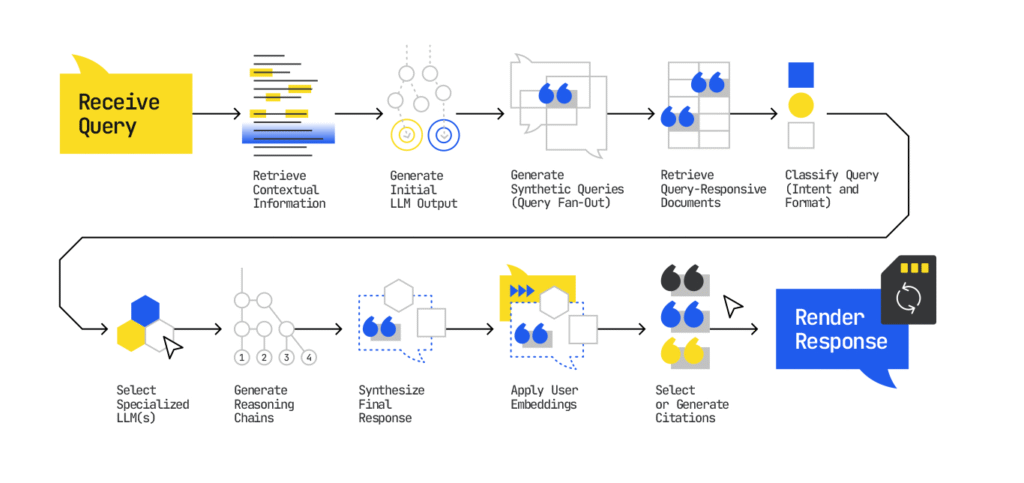
In summary:
- A user enters a query on Google (or Chat GPT).
- AI Mode (like other LLM platforms) kicks off a query fan-out process to find related, relevant queries to the primary one.
- Each query is searched independently against Google’s index to find semantically related documents. Here’s an example from Perplexity AI:
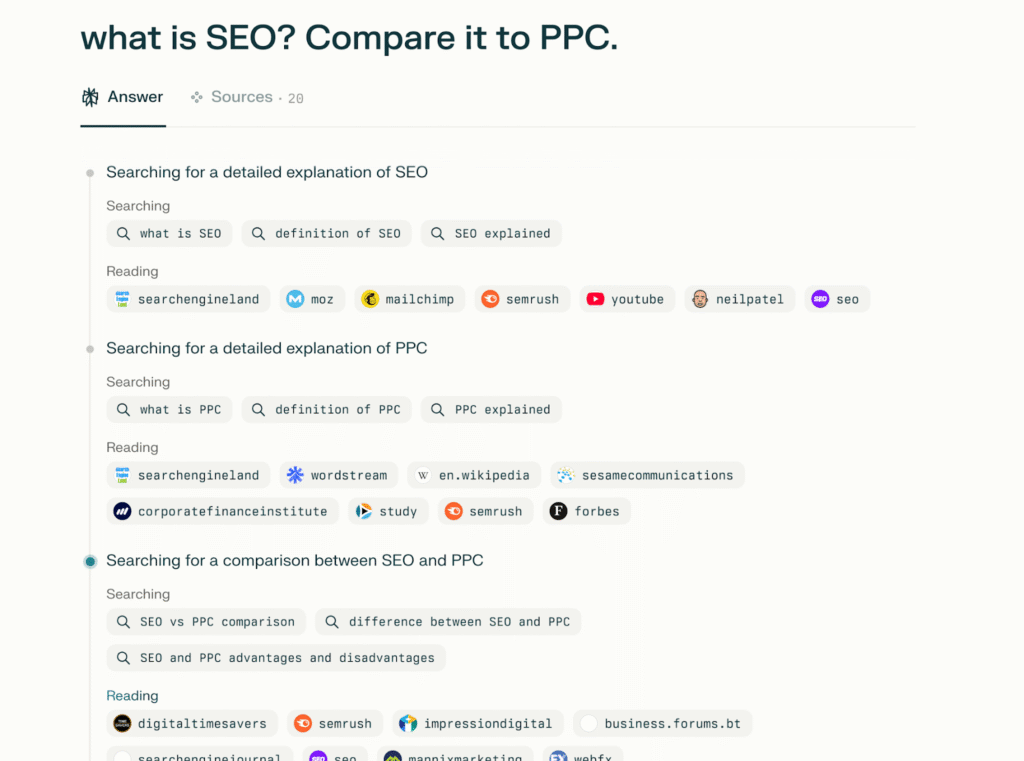
- All retrieved documents are ranked based on how their vector embeddings (the numerical representation of data that LLMs understand) match the queries.
- The best matches create a ‘custom corpus,’ a smaller group of content selected for the user’s specific search.
- AI Mode synthesizes this corpus into a single, context-aware, conversational answer that anticipates and addresses follow-up questions. It’s why a tool like Perplexity AI provided these follow-up questions when I asked how SEO helps build brand awareness in a way PPC doesn’t:

While this AI chat process may seem more of an advantage to end users than business owners, it’s your opportunity to create product-centric content that helps you capture leads directly on LLM search engines.
Let me explain:
Elizabeth Reid, VP, Head of Search at Google, explains how AI Mode can help users cut through lengthy search processes and make purchase decisions faster. In her own words:
“Often, you come to Search to get something done, and now … AI Mode (can) help save you time with tasks like purchasing tickets.
Just ask, “Find two affordable tickets for this Saturday’s Reds game in the lower level,” and AI Mode will kick off a query fan-out, looking across sites to analyze hundreds of potential ticket options with real-time pricing and inventory, and handle the tedious work of filling in forms. AI Mode will present ticket options that meet your exact criteria, and you can complete the purchase on whichever site you prefer — saving you time while keeping you in control.”
From the GIF above, we can see that Google’s AI mode streamlined the search to the searcher’s exact criteria, and all they have to do is choose a website from the list of options.
The same works for other LLM search engines as well. For example, a user who types “best noise-cancelling headphones under $200” will receive detailed product suggestions that include prices, reviews and direct purchase links. All without having to sift through multiple websites.

For businesses, this means your product pages (or blogs), case studies and comparison content can be surfaced directly in these recommendations when customers look for products/services like yours.
Recently, we’ve seen that our clients (including our own website, HigherVisibility,) have gotten more impressions and leads from LLMs. This isn’t coincidental, actually. We consistently optimized their content to align with how AI systems parse and present information to users.
Case in point, say a searcher, who lives in Oregon and needs a plastic surgeon close by, enters this query into ChatGPT:
“I am a professional in my mid-40s living in Salem, Oregon. After years of putting my own needs last, I’ve finally decided to explore plastic surgery options to enhance my confidence and feel more comfortable in my skin. I’m looking for a reputable plastic surgery practice known for high-quality procedures, personalized care, and excellent patient reviews. Since I value experienced surgeons and a practice that treats patients with dedication and attention, I want recommendations for trusted providers near me who can guide me through the process safely and effectively. Can you suggest some top plastic surgery clinics or surgeons in Salem that fit this description?”
The first clinic recommended is one of our clients, Neaman Plastic Surgery & Medi Spa, a plastic surgery clinic based in Salem, Oregon:
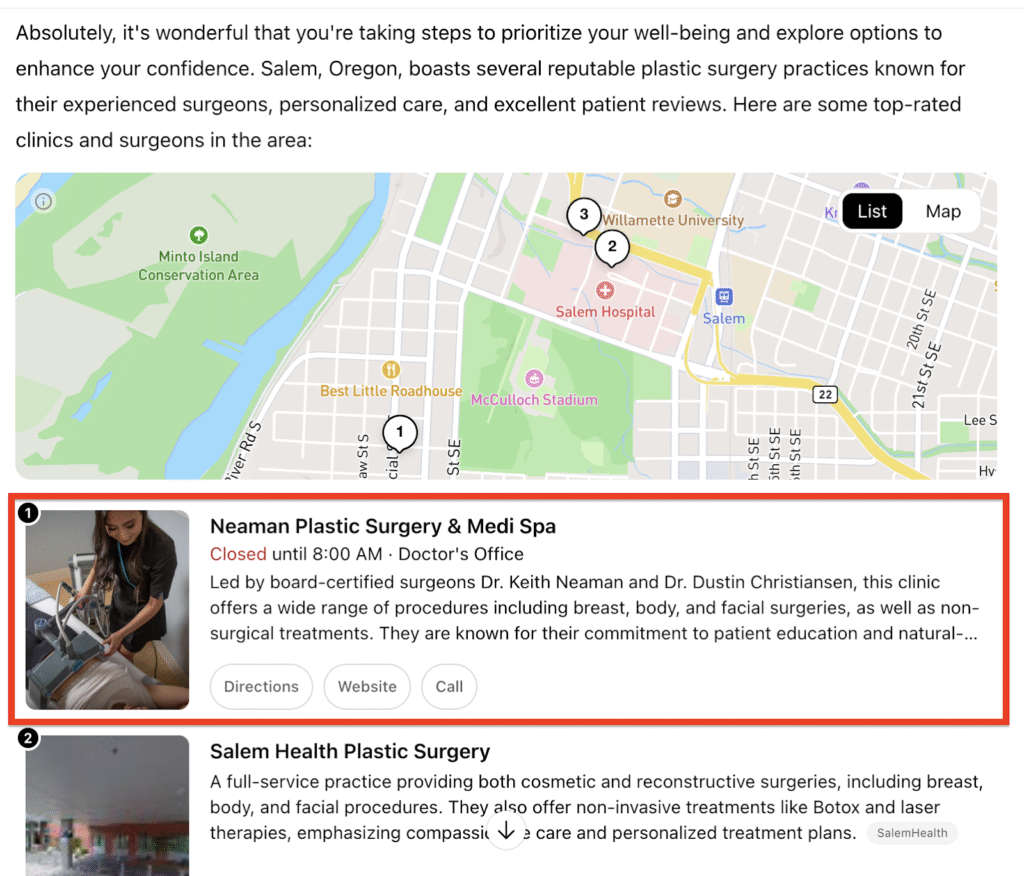
The major reason is that we optimized their website to align with this search intent. We also optimized for long-tail, conversational-like search queries, especially for searchers within the Oregon and Salem area.
These types of queries are more targeted, and searchers in this category are actively looking to convert.
In this scenario, one of the keywords we prioritized is “best plastic surgeon in Oregon.” This keyword has a pretty low search volume (110) compared to “best plastic surgeon in the US”, with a higher search volume (720).
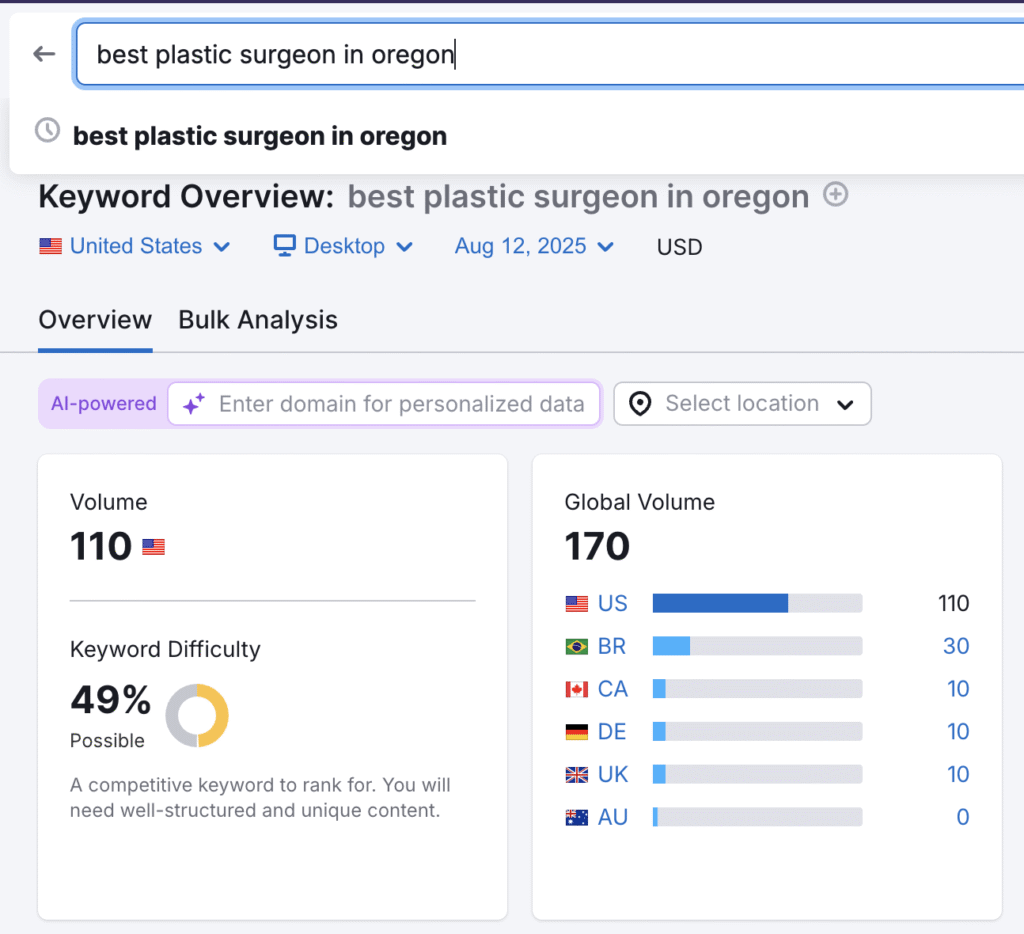
However, people searching for the broader term may simply be browsing or researching options. They’re not necessarily ready to book a consultation. On the other hand, someone searching “best plastic surgeon in Oregon” is likely looking for a local provider with the intent to schedule a procedure soon. Or at least, ask about the procedure.
I checked the references and my predictions are correct. ChatGPT cited our main landing page, titled “Best Plastic Surgeon Salem, OR”
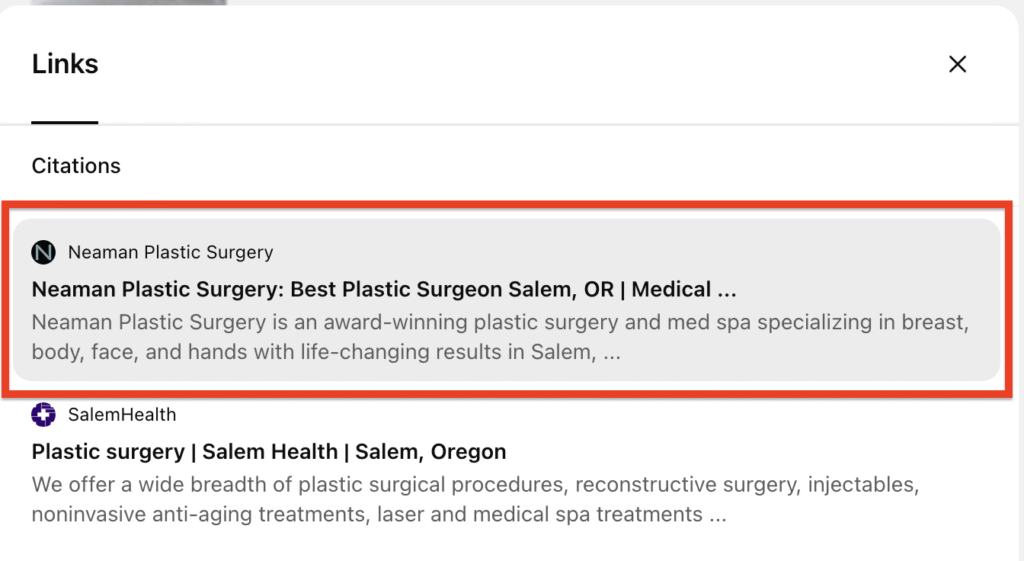
By focusing on these tong-tail, targeted keywords with clear buying intent, we can create content that specifically addresses their pain points. This approach increases their chances of appearing in the results generated by the LLMs.
You can read the full case study here.
I’ve also seen this play out in other industries. For example, one e-commerce store owner on Reddit shared that they got a new lead from ChatGPT:
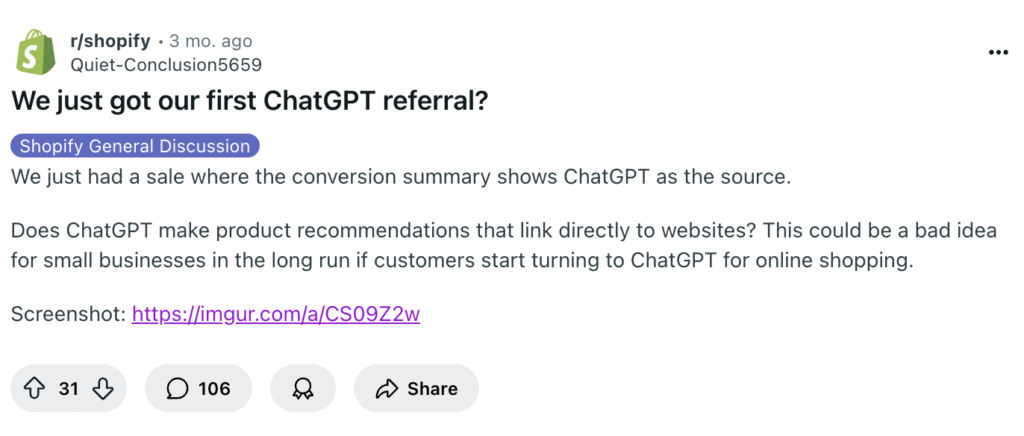
Proof:
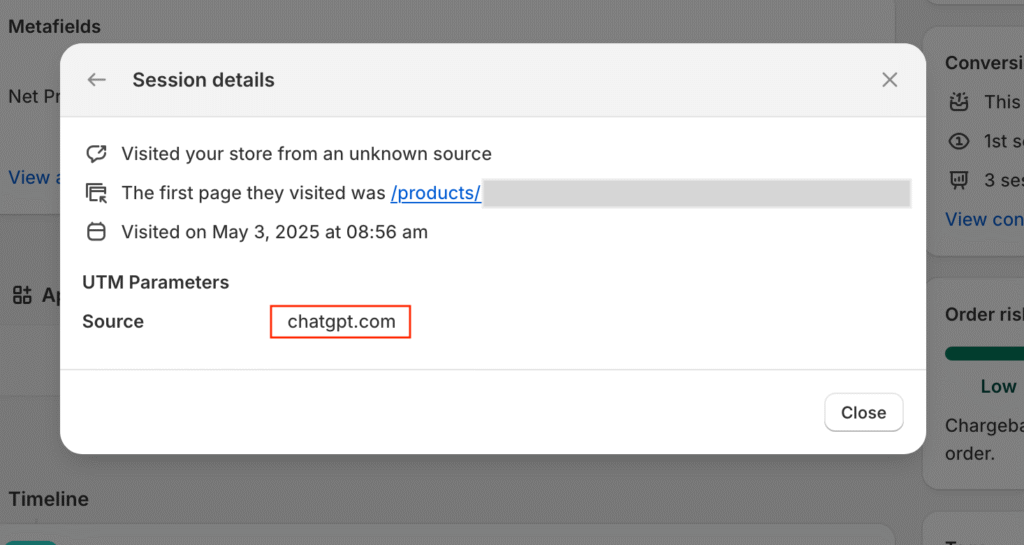
According to a study from Forrester’s Buyers Journey Survey, 2024, 89% of B2B buyers use generative AI to inform their purchase journey. If your content is optimized accordingly, you’ll most likely be mentioned and be able to capture purchase-ready leads directly to your website.
You can Attract Referral Traffic if You’re Visible for Your Category Keywords
In AI search, placement matters as much as ranking in traditional search. LLMs like ChatGPT draw from training data that includes public sources such as Wikipedia, Reddit, news sites, books, and licensed publisher content. They often cite these sources in answers, giving users a direct path to click and learn more. Your job is to ensure your content appears when these citations happen.

Let’s revert to the example I cited earlier on the “best noise-cancelling headphones under $200.” The answers featured on ChatGPT were directly pulled from a blog post published by the owner of the brand, Soundcore:

In this case, the brand has published several category-level content that:
- Matched user search intent.
- Contain structured, decision-ready details such as price, features, and “best for” use cases.
- Optimized for category-level keywords as seen in the blog title:
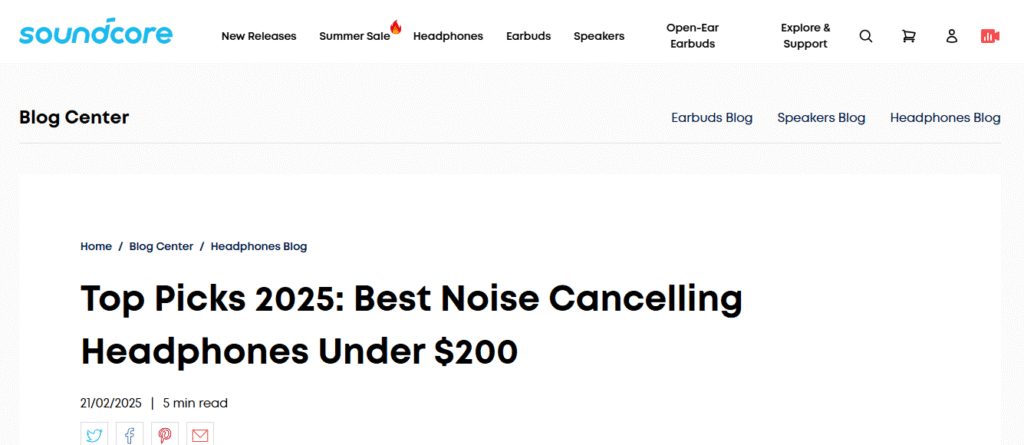
Because of this, ChatGPT can associate the brand with the product and the problem it solves for users. The results? Soundcore’s blog post link appeared directly beside the featured answers. Users who’re interested in the headphones can click through and purchase directly from the website.
Now imagine the ripple effect when they optimize their blog posts/high-value pages for multiple category keywords!
Kelsey Libery, co-founder of LedeTime.ai, an AI-powered digital PR tool, shared some light on this in her article on AI-Powered SERPs and LLMs. She said:
“…LLMs, such as ChatGPT and Gemini, power these systems by synthesizing vast amounts of data to provide conversational, non-deterministic responses.
Ultimately, brands that adapt to how AI retrieves, interprets, and generates information could increase their long-term visibility, while those that don’t risk losing a critical new traffic source.”
Ahrefs studied over 750,00 brands and discovered that branded web mentions are the highest influencer of your appearance in AI overviews.
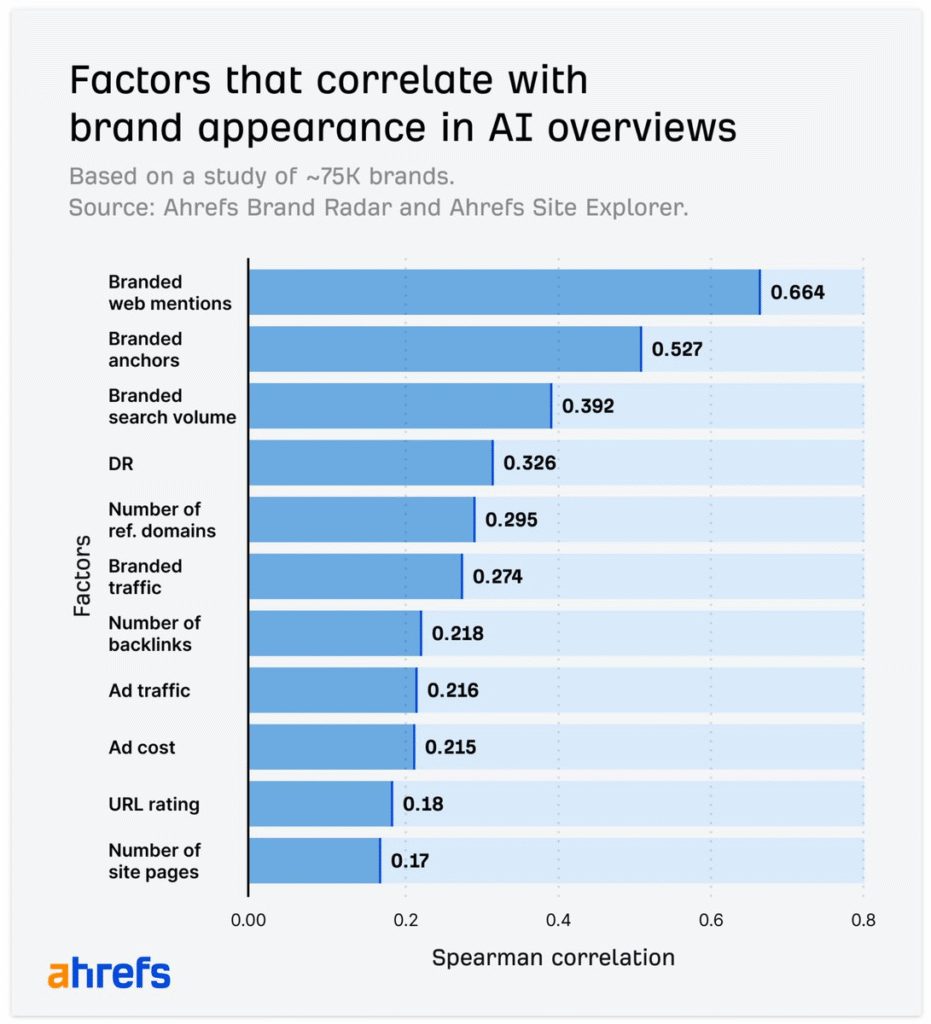
In simple terms, the more content you publish about your product, the problem it solves and how it does it, the higher your chances of appearing on LLMs for related search queries. Tim Soulo, CMO at Ahrefs, explains why this happens in a post on X:
“… if you’ve read Stephen Wolfram’s excellent piece “What Is ChatGPT Doing, and Why Does It Work?” (as I urged in an earlier post), then you should know that LLMs work by predicting the next word in a sentence based on statistical co-occurrence from their training data.
So if we want AI to mention “Ahrefs” when talking about “marketing tools,” there has to be a lot of co-occurrences of these two things in the training data of this AI model.
And a big chunk of LLM training data is typically coming from the web. And that’s basically the gist of it.”
So…
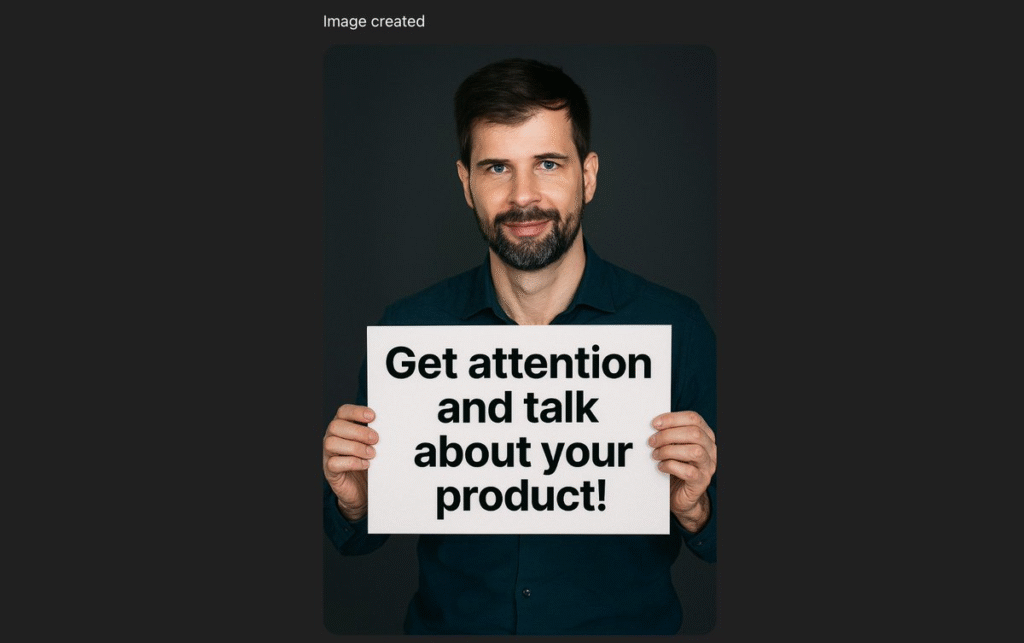
Thanks for the picture, Tim!
“Fresh” Content Lets You Rank on Traditional SERPs and LLMs
While AI visibility is the new frontier, traditional search engine rankings still matter. In many cases, they feed directly into LLM results.
Remember, Google’s AI Mode is built on top of its classic index. That means the same content that wins you a spot in AI-generated answers can also help you dominate traditional SERPs (search engine result pages).
I’ll explain why:
One of the major ways to increase your rankings on the traditional SERPs is to publish high-quality, valuable content. This means your content has to:
- Meet user search intent.
- Be detailed, and should cover the breadth and depth of the topic (i.e. helpful content).
Take Google, for instance. In 2022, they released a “Helpful Content” update that rewards websites that publish “fresh” or “new” content. In their own words, this type of content should “provide original information, reporting, research, or analysis.” In simple terms, something different from what’s already on the Internet.
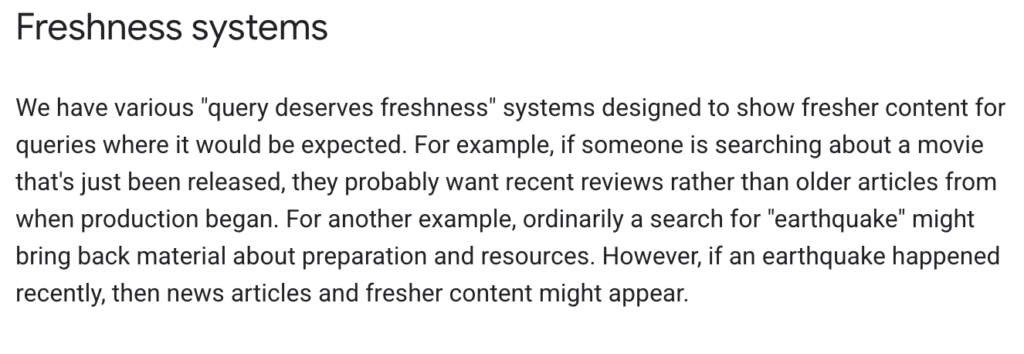
This means that the more recent and informative your content is, the higher your chances of topping traditional search results for user search queries.
The same applies to LLMs. Ahrefs analyzed over 17 million citations across 7 AI search engines (including Google’s AI Overviews) and discovered that they prefer content that is 25.7% fresher (with ChatGPT having the strongest preference with 2.8 years max.) This means you should update your high-value pages at least every 3 years to keep your content fresh.
This is a win-win for you. Updating your content regularly will help you to:
- Rank high in the traditional SERP results.
- Appear in AI assistant responses for purchase-intent searches.
- Increase your search engine real estate (that is, you can rank simultaneously on Google’s AI overviews, LLMs, featured snippets, and People Also Ask sections).
Case in point: This year, we updated our content on “Best WordPress design agencies in 2025,” and rank first place on Google for the target keyword:
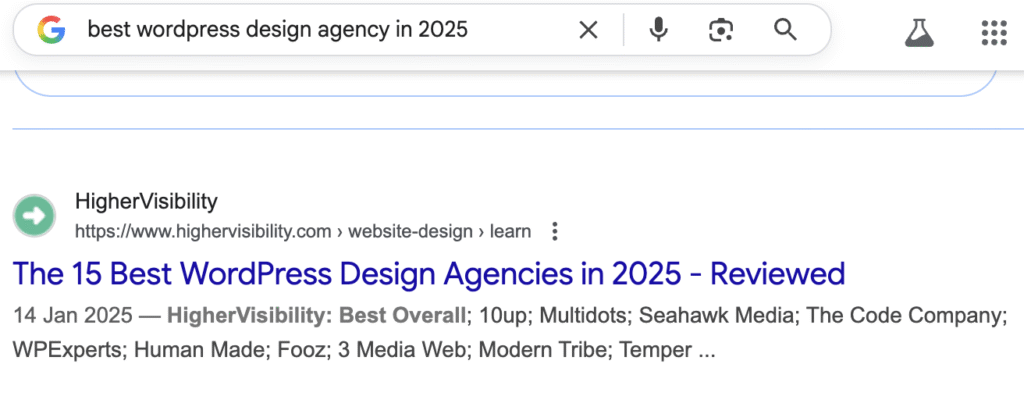
We also appear on AI Overviews for the same keyword, with our blog post link referenced as the source:
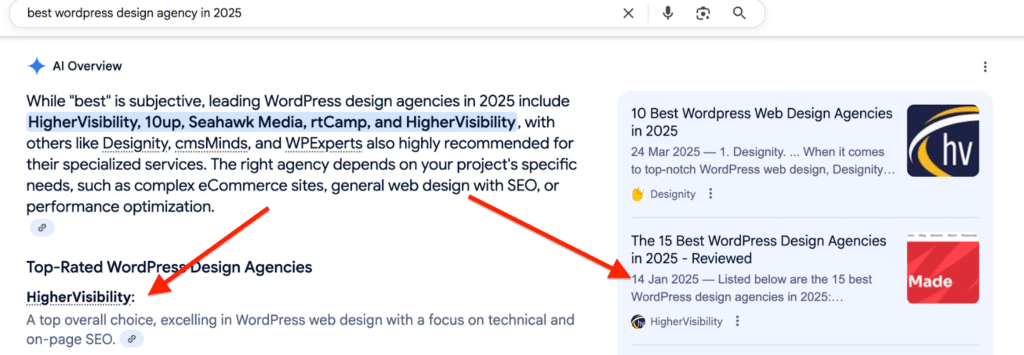
If you type the same prompt into ChatGPT, we top the list of recommendations:

The content referenced? Our updated blog post on Best WordPress Design Agencies in 2025:

This multi-visibility helps us to capture leads from three entry points (organic Google rankings, AI Overview citations and ChatGPT) directly to our website.
How to Know if Your Content (or Brand) is Mentioned on LLMs
If you’ve invested time into optimizing your content for AI, the next logical question is: how do I know if I’m showing up in AI-generated answers?
Currently, LLMs don’t have a proprietary public analytics dashboard to track traffic and other vital metrics. However, you can use an SEO analytics tool like Ahrefs to track your visibility on these platforms. Ahrefs Brand Radar, for example, constellates all your data from ChatGPT, Perplexity, AIOs, Gemini, and Bing Copilot all in one dashboard. This is how it looks:
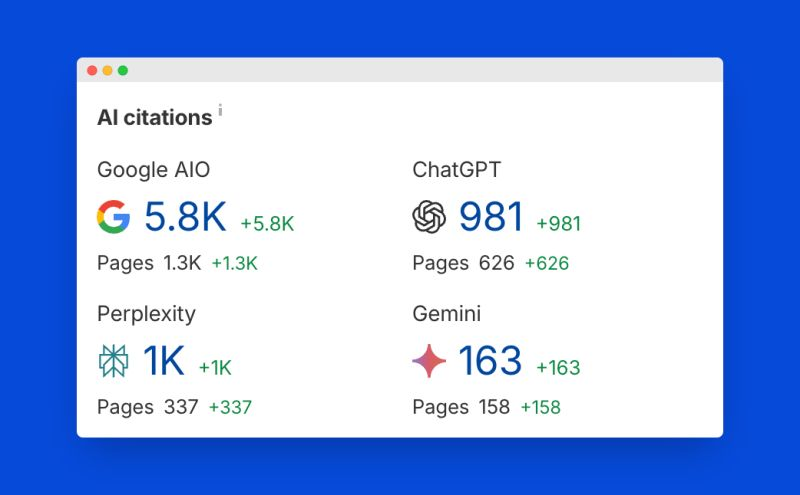
Normally, this process takes much time and money too. First, you’d need to generate tons of relevant prompts and fan-out queries for your main keywords. Then, you’d have to set up thousands of API calls to the major LLMs. The volume of data output will be (way too) overwhelming to sift through manually.
With Ahrefs Brand Radar, all the grunt work is handled for you. Instead of trying to figure out things on your own, you can identify (fast) and focus on how users are searching for a brand like yours and where you’re regularly cited.
You can also use Google Analytics (GA4) to track your website traffic and leads. All you need to do is to create a custom filter in your GA4 property and apply a regular expression (Regex) filter to capture AI traffic.
Once you’ve applied the filter, GA4 will display a visual snapshot of all traffic sessions that match the regex filter. This is how it looks:
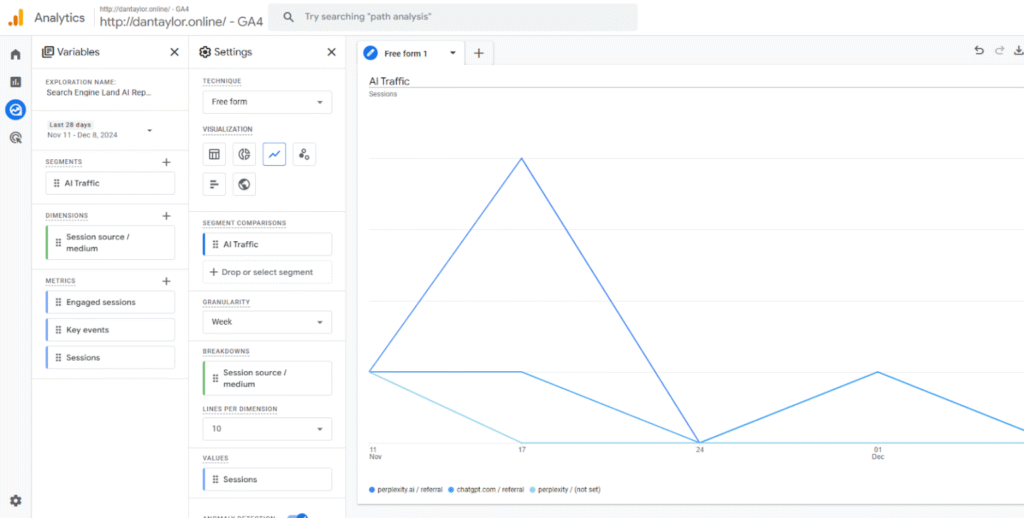
Read more on how to do it here.
At HigherVisibility, we’ve even taken this a step further. We have an in-house tool to help business owners to track brand mentions, citations, and referral traffic from LLM platforms. What this means is that you’d know:
- Where your traffic and brand referrals come from.
- Why your website is referenced.
- How to improve your content strategy to solidify your brand authority and get more brand mentions in generative and traditional search.
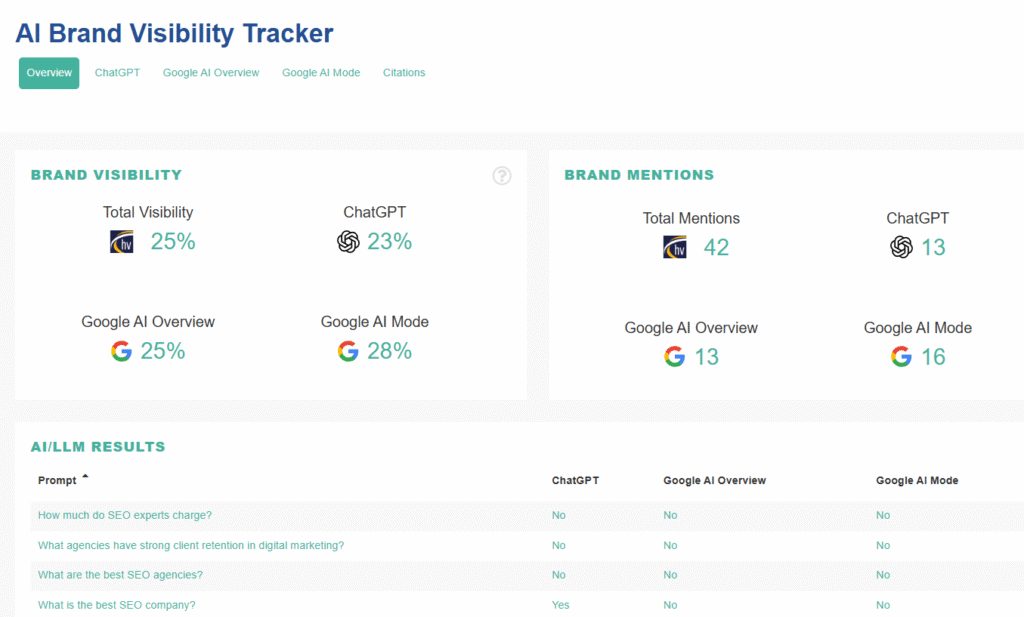
If you’d like to expand your visibility on these AI search engines and attract high-intent leads directly to your website, contact us today!
